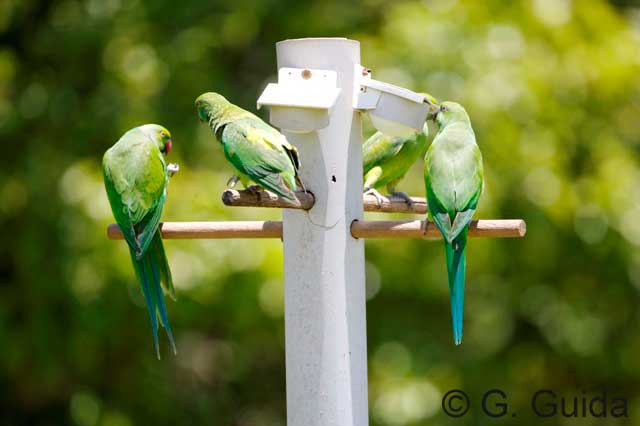
Echos at feeding hoppers
|
| |

Echo Parakeet in flight
|
| |

Echo with PBFD
|
| |

Echo chick in nest box
|
| |

Disease screening
|
| |

PVC nest box
|
|
The Echo Parakeet Psittacula eques was once common on Mauritius but began to decline in numbers and range in the mid-1800s. By 1986 the population was estimated to be 8–12 individuals, although it is now thought, due to the discovery of previously unrecorded breeding groups, that there may have never been less than 20. The present wild Echo Parakeet population is restricted to an area of less than 40 km2 of remnant native upland forest within the 6,800 hectare Black River Gorges National Park. The survival of this species is threatened by the limited availability of natural nest sites and food, competition from exotic birds such as Indian Mynahs and Indian Ring-neck Parakeets, predation by introduced mammals including Ship Rats and Crab-eating Macaques, and disease.
Conservation efforts to recover the Echo Parakeet were initiated by the Forestry Service and the International Council for Bird Preservation in the early 1970s and intensified by MWF and the National Parks and Conservation Service since 1987.
The Echo Parakeet was until recently one of the most intensively managed avian species in the world. Techniques used in the past have included habitat protection and improvement using fenced and weeded forest Conservation Management Areas (CMAs), rat control around nest sites, captive breeding, manipulation of breeding pairs including egg harvesting and chick fostering, supplementary feeding and provision of nest boxes. Between 1993 and 1997 the management efforts were further refined. From 1997 onwards the emphasis was on protection of nest sites (from predators, competitors and weather), providing additional nest sites in the form of nest boxes, supplementary feeding wild birds, manipulation of wild broods (downsizing and upsizing), regular inspection of active nests and weighing of chicks, rescuing sick or underweight chicks, and hand rearing and releasing chicks back into the wild. Chicks produced by captive birds at the GDEWS were used in brood manipulations in the wild or to boost the number of chicks released to the wild. Between 1997 and 2005 a total of 139 birds were released into the wild at 3 different release sites. By 1999, the captive breeding programme was no longer required, due to the significant increase in bird numbers in the wild.
With the population projected to exceed 300 birds, the 2005/6 breeding season was to be the final year of intensive management for the programme. However, an outbreak of the highly contagious and fatal Psittacine Beak and Feather Disease (PBFD) during 2005 forced a change of management early in the 2005/6 season. Since then the project has been working to a minimal management strategy, aiming to reduce the risk of spreading PBFD between the birds, whilst ensuring continued good breeding productivity. The monitoring and management of PBFD in the Echo Parakeet population has been a major project aim over recent years. Blood samples from the birds show that the virus is widespread in the population, with over 30% of Echo Parakeets sampled having encountered the disease. Chicks and juvenile birds are more vulnerable to PBFD infection and the majority of juvenile Echo Parakeets show some clinical symptoms of the disease.
Mortality of the under two-year-old birds is high, attributed to PBFD and its associated health effects. From our disease screening we have observed improvement in clinical symptoms in affected birds and it has been established that Echo Parakeets can recover from PBFD.
The Echo Parakeet population has increased from the 8–12 birds known in 1986 to an estimated 540 birds in April 2011, with some 125 chicks fledged in the wild in the 2010/11 season. The population increases in recent years are the result of higher numbers of chicks surviving to fledging due to the management strategies used by the programme and the consequent increase in the number of breeding age birds.
The Echo Parakeet team actively manages 108 nest sites, including 85 artificial nest boxes, 75% of which were used in 2010/11. Wooden nest boxes require regular replacement as a result of damage by termites, Echo Parakeet chewing, and rot. A new durable PVC nest box has been developed to reduce the need for replacements. Following a successful trial, 10 of these new nest boxes have been installed in the forest, 9 of which were accepted and used by the parakeets.
The team will continue with the minimal management techniques including nest protection, collection of breeding productivity data, population monitoring, disease screening and supplementary feeding.
Our Echo Parakeet project is the world’s most successful parrot recovery programme worldwide.
|
|